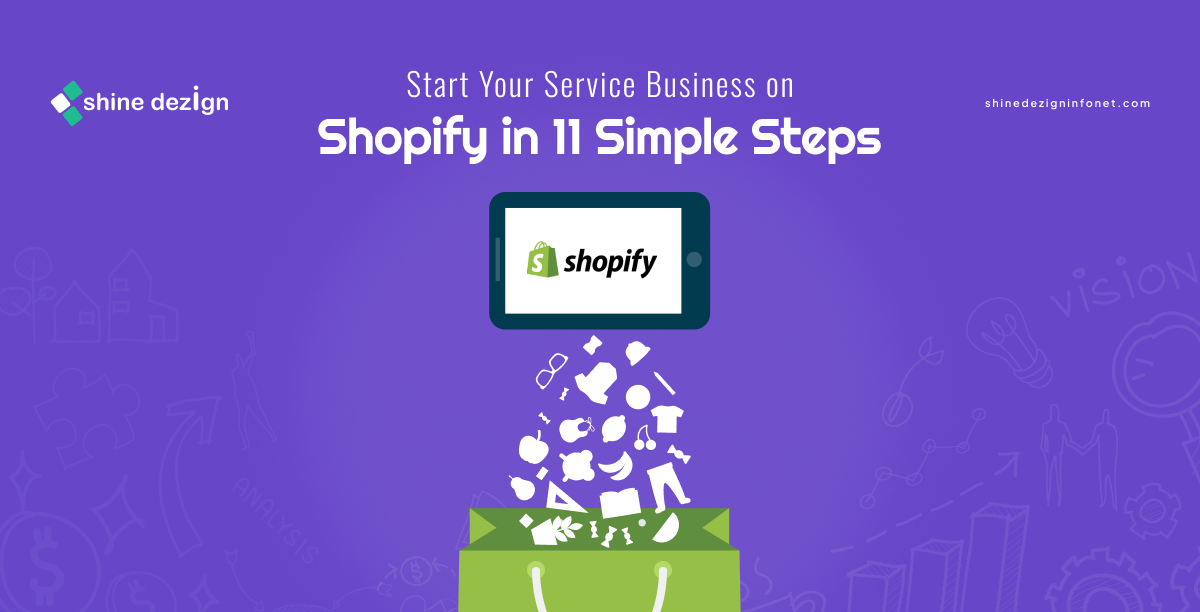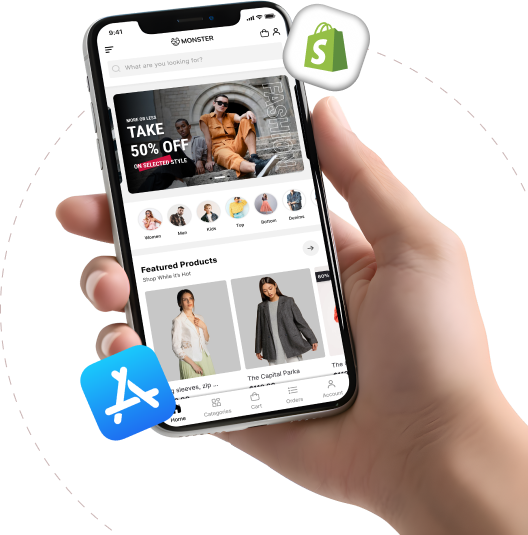Table of Contents
In the growing era of digitalization, it is necessary for all the business and start-up owners to integrate with online platforms to grow digitally as well. And availing your service – providing business online is crucial to reach your target audience easily across the world.
Whether you offer consulting, coaching, or other services online, it is essential for business growth and it is easy for the target audience to access these services as per their requirement. Shopify provides its users a platform to start their service business to help them grow.
What is Shopify?
 Shopify is a commerce platform that helps you to sell their services in the form of physical products, advice, consultancy, and many more, online and in person by building a Shopify store. Entrepreneurs, Retailers, and global brands use Shopify to process sales, run stores, and grow their businesses.
Shopify is a commerce platform that helps you to sell their services in the form of physical products, advice, consultancy, and many more, online and in person by building a Shopify store. Entrepreneurs, Retailers, and global brands use Shopify to process sales, run stores, and grow their businesses.
With Shopify platform, anyone can start their e-commerce business, and connect with their Target Audience hassle-free, and manage and grow their business.
Why choose Shopify for your Service Business?
 Shopify, being an E-commerce platform, often extends its capabilities far beyond selling physical products. It even supports customizations through Shopify app development, allowing you to tailor your store to suit unique business service needs. Shopify is a professional and user-friendly online platform for service providers.
Shopify, being an E-commerce platform, often extends its capabilities far beyond selling physical products. It even supports customizations through Shopify app development, allowing you to tailor your store to suit unique business service needs. Shopify is a professional and user-friendly online platform for service providers.
• Shopify provides a versatile service listing, it creates a service listing with a detailed description, pricing and other aspects of your service or service – based product. It helps you to describe your service effectively to the customer.
• Shopify provides you the option to implement an appointment booking option to streamline client appointment schedules. You can manage calendar and client appointment effortlessly.
• It offers a secure payment option, which helps your customers to make payments without any inconvenience.
• Shopify offers a variety of themes to customize your Shopify store as per your service or service – based products requirements to attract and retain customers.
What kind of Service business you can sell on Shopify?
 Shopify caters to a wide range of Service Business. Being an adaptable and versatile platform, Shopify is ideal of various types of Service Business, few of these are:
Shopify caters to a wide range of Service Business. Being an adaptable and versatile platform, Shopify is ideal of various types of Service Business, few of these are:
Rental Services:
The rental service industry, which offers physical products, services, and other things on rent for a specific period, is fully thriving on Shopify. Whether you want to rent a product, costume, or service, you can rent easily it through Shopify store. Shopify robust system handles the payments, bookings and other management efficiently.
Coaching services:
The demand for online coaching services has significantly increased, it is evidenced by over 1.5 million searches over life, business and executive coaches. Whether you specialize in personal development, career coaching, executive coaching, Shopify provides you a platform to streamline your expertise to the customers as a service business.
Consultancy:
Shopify provides a professional and efficient way for consultant service business in various fields, such as marketing, finance, human resources, SaaS, IT, and accounting, to offer their expertise.
Event Management:
Event management compresences personal and professional events like weddings, conferences, seminars, concerts, formal and informal parties etc. With Shopify, event management businesses’ can sell their services by building a Shopify store and reach their target audience efficiently.
Classes or training sessions:
As the market and demand for online classes and training is booming, Shopify if providing a platform where user can structure and sell their training services in various formats which includes packaged courses, subscription- based models, and more.
Examples of Shopify’s Service based business:
The Fitzroy:
Fitzroy is a clothing rental service that offers customers the chance to rent clothes for special occasions instead of buying them. It is a unique and sustainable clothing rental service to allow customers to rent fashionable and expensive clothes for any special occasion or for daily wear also.
The Mobile Locker:
The Mobile Locker is a Shopify based service business allowing event management companies to rent storage solutions as a reserve locker for safely storing valuables, which are not allowed in the venue, of the attendees.
Happily ever borrowed:
It transforms traditional industry for bridal accessory rental service using Shopify. Happily ever borrowed provides rental service for bridal accessories with a unique offering like, the “Send Before You Spend” Box.
Novanym:
Novanym is a Shopify Service based branding agency that helps new startups to nail their names, domains and branding.
How to set up a Shopify store for your Service Business?
 As of now, another thought that struck in mind is how to set up or build a Shopify store or what steps are included in building a Shopify Store? Here is step by step guide for you to set up your Shopify store: –
As of now, another thought that struck in mind is how to set up or build a Shopify store or what steps are included in building a Shopify Store? Here is step by step guide for you to set up your Shopify store: –
1) Think of a Business Idea:-
A solid business idea is the core concept for a blooming Shopify store. Formulate a solid business considering the following things: –
• Prepare a business idea by prioritizing your hobbies and skills.
• Analyse the market trends and demands.
• Prepare a business idea by prioritizing your hobbies and skills.
• Observe the market crowd, to know about your competitor in the market.
• Settle a business model and work accordingly to shape your brand.
2) Create your Shopify account:-
For building a Shopify store, the first step is to create a Shopify account. Here are few simple steps: –
• Pick up a Shopify plan by analyzing its features and pricings.
• Select a free trial, then answer a few questions regarding your vision, business plan and business location. Then create your Shopify I’d.
• Start creating a Shopify store. (Shopify assigns a URL to every newly built Shopify store. Make sure to get a custom domain name, representing or related to your brand and service, before your free trial ends to make sure the store run continuously)
3) Add Required business Information:-
Then the next step is to add your business information in the “Setting” menu under “Store details”, like product details, legal business name and shipping details for billing information and set your product currency, if you are opting for Shopify payment make sure to change the currency.
4) Get familiar with navigating dashboard:-
As you are building your Shopify store from scratch, you will need to get familiar with the dashboard. It will have eight main options:
• Home: It consists of the main information about the store and outstanding tasks.
• Orders: Information about order status.
• Products: Manages individual product pages, collections and inventory, and about gifts to the customers.
• Customers: Gets information regarding customers and companies to manage your B2B experience.
• Content: Stores your web files and related information.
• Analytics: Provides insightful reports regarding sales, conversion rates, average order value and more such data and information.
• Marketing: Insights regarding marketing and channel activities and general store data.
• Discounts: Creates and manages discounts and related information.
5) About adding products:-
Add your products and collection, before choosing the theme to customize your website design as per the product requirement. The price of products and their style of displaying will determine your theme and its customization. While adding your product, also add product description and variants (sizes and colors). Assign a category to organize and manage your products.
6) Choose Shopify theme:-
Now choose a theme for your Shopify store. Shopify theme is the face of your e-commerce website. Keep these points into consideration while choosing a Shopify theme:
• Price: Compare the price of all the themes to make sure the theme you choose for your business is justifiable in context of price
• Speed: Choose a theme with no unnecessary code to maintain the speed of your Shopify store.
• Developer, SEO and Growth features.
• Support and priorities.
How to Install a Shopify Theme: Steps to install a Shopify theme:
• Open the “Dawn theme page” from Shopify store.
• Click on “Try theme”. You will find various themes.
• Customize it according to your brand and publish it once it is ready.
7) Working on Homepage:-
Homepage is the face of your website, it is priority to customize it according to your website and products. Your homepage should be impactful to boost your brand and to convince the people to visit your store for purchase. To build your Shopify store’s homepage, go back to online store then Themes and then customize your homepage.
Things to keep in mind to make your homepage impactful:
• Shopify headings, Brand Name.
• Easy access to products and collection page.
• Product explanation and images, to retain customers.
• Feature customer review and testimonials.
8) Creating Shopify Store’s basic page:-
Basic page consists of all the information regarding store to build its trust, reliability among customers, boosts brand recognition and hiring shopify experts to guide you in setting up these terms can enhance your store’s credibility. Basic page includes:
• About Us: A good about us page includes Mission Statement, Product Description, Achievements and reviews, creative presentation.
• Contact: This option includes contact details related to business like Business Phone number or Email, physical address (if required), Mailing address, feedback forms, links to social media accounts.
• Privacy Policy: This option is required to ensure your customers have personal information and let them know how you handle their personal information.
• Terms and Condition: Under the Terms and Condition page you protect yourself and your business, by adding disclaimers, rules and policies regarding your Shopify store.
• Help/FAQs: To save time for your clients and customer support, this option must be added to your basic page. This section consists of:
1. Shipping and return information.
2. Refund policies.
3. Product details like measurements, weight, etc.
4. Address and Purchase process description.
9) Shopify store’s Menu:-
For customers to access your products and collection page quickly and hassle-freely, design an effective menu. To create a menu, go to “Online store” and then on “Navigation”, Shopify will create two menus – main and footer by default. For your Main menu – click “add menu items” then start adding product name (title of the page that will appear on the menu) and link (that will lead to the menu). Now you can drag and drop your items to the main menu, which will appear in the top menu.
10) Deciding payment options:-
Shopify payments option is the payment processing function available on Shopify. If you are eligible to use Shopify payments, then you can integrate it easily without any third- party transaction fees. To enable Shopify Payments; go to “Settings”, then “Payments” option and click on “Activate Shopify Payments”.
11) Launch your Shopify Store:-
After building up Shopify Store, it is time for your store launch campaign. You can launch your store through organizing an email campaign, Social Media Marketing, implementing ecommerce strategies, offering early birds discount and gifts, etc.
Summing Up
Shopify provides an e-commerce platform for business owners to grow digitally. Setting up a Shopify store will help businesses to provide their services and products online to their customers. By following these simple steps any user can start their service business on Shopify by building a Shopify store.
Moreover, you can also hire Shopify experts as Shinedezign Infonet has a team of professional that helps you to start your service business hassle-free and strive growth without worrying about business setup.

















